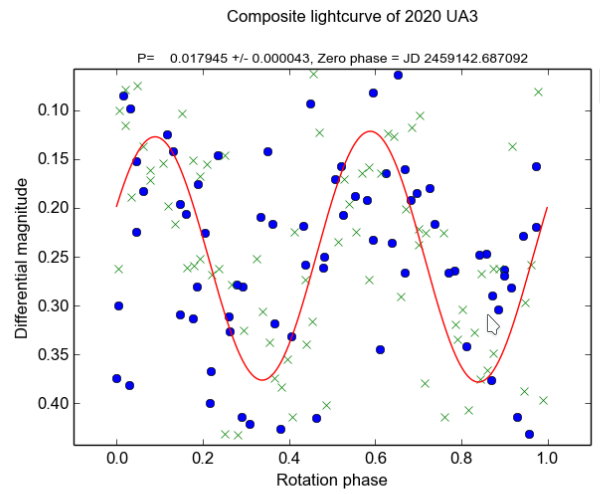Determination of colour indices of super-fast rotator near-Earth asteroids
- Faculty of Physics, Adam Mickiewicz University in Poznan, pkolenczuk@gmail.com
1.Introduction
In recent decades, we have been observing an exponential increase in near-Earth asteroids(NEAs) discoveries especially smaller than 200m(VSAs). According to the Holsapple model and observational data[2], VSAs can rotate much faster than larger asteroids. The reason for this is the monolithic structure as opposed to the larger asteroids made of smaller stones, the so-called rubble pile. VSA holds together mainly due to cohesive forces, not gravity, so many of them have rotational periods shorter than the 2.2h spin limit typical of rubble piles.
However, we do not know much about these objects, especially in terms of their taxonomy, which may turn out to be the key to a better understanding of the composition of VSAs, thereby their threats, and a better determination of the rotation limit taking into account the taxonomic type. Only ~1\% of these bodies are assigned a taxonomic class[7].
2.VSA observation issues and methods
VSAs are faint, with a mid-class telescope(<=2m), they can only be observed during close approaches, when they move quickly on the celestial sphere. This makes observations difficult using the classical methods used for further objects.
In our photometric observation, the telescope follows the asteroid keeping the NEA image circular on CCD frame, but the star images extend into long trails. An example of such observations at extremely high speed NEA on the sky was presented at the last year's EPSC(see[4]). Luckily, there was a photometric night then and instrumental measurements were enough to determine the rotation period. In worse conditions and/or when we want to determine the colour indices, we need accurate differential photometry. For this purpose, we use a circular aperture for the asteroid image and a pill aperture[1] for comparison stars images. We raised the issue of the use of the pill aperture in NEA photometry in[5]. Solar analogs from the PanSTARRS catalog were used as comparison stars.
An appropriate observation strategy is essential in determining the color indices of newly discovered NEAs. We need to know the rotation period. Many VSAs are superfast rotators(P<2.2h), and our observations of new objects are adapted to effectively detect periods between almost the entire range at relatively high S/N.
The general idea is to make 10s exposures for 15min (detection period ~1-15min) followed by 60s exposures for 2h (detection period ~5-120min) and, depending on the observation time, repeat these observation blocks several times. Exposures in these blocks are made with wideband filters.
Between these blocks we make a sequence of B,L,V,L,R blocks - each with 60s exposures taken for 15-20min, where L is our broadband filter.
Then, by moving the B,V,R lightcurves to the most accurate L lightcurve, one can determine the magnitude shift in relation to the L lightcurve, obtaining L-B,L-V,L-R, hence we get B-V and V-R.
We noticed that in the case of rotation periods close to the time of colour exposures, we can assume that each measurement is averaged brightness over the period. Then we determined the brightness in a given filter from the arithmetic mean, and the uncertainty from the standard deviation of the mean. The same can be done when the exposure time is a multiple of the period.
To check the impact of the assumption of ideal averaging over period on the results, we run simulations. We assume that the synthetic composite lightcurve obtained from 10-second exposures is the ideal curve. We integrate this synthetic composite lightcurve over the period to get the brightness we would get if the exposure time were equal to the period. Then we integrate the part of the curve corresponding to the color exposure time and repeat this by slightly shifting the phase from which we start to integrate, until we return to the initial phase. In this way, we get all possible values that we can get at a given exposure time. Then we compare the mean result with the value obtained by the integration over the period.
3.Observation and results
We conducted our observations in search of super-fast rotating VSAs between October 2020 and April 2021. We were able to determine the physical properties of several objects. Most of the observations were made with the 0.7-m RBT/PST2 telescope at the Winer Observatory in Arizona. For 2021 DW1, we organized a larger campaign involving telescopes from around the world. We devoted a separate poster to this object at this conference[6].
Below are the results for 2020 UA, which we observed on 20th October 2020. More details and results for the remaining asteroids will be announced at the conference.
In Fig.1, we present the composite lightcurve for the best solution of the rotation period P=64.60+/-0.015s and amplitude 0.25mag. Since the time of colour exposures is 93% of the rotation period, we checked whether we can assume that P=texp for the determination of indices. It turned out that the impact was negligible, the average difference between the true average brightness period and our results is 0.0003+/-0.0047mag. The final indices are presented in Fig.2.

Fig.1.Composite lightcurve for 2020 UA. We used two 10-s exposure blocks during 15min each. The break between the blocks was 6.5h.
Fig.2.Colour-colour plot. The blue point is the result for 2020 UA(brightness in g,r,i obtained using PanSTARRS solar analogs), the uncertainty range is marked with a cross. Other symbols represent data for NEAs of various taxonomic types taken from[3].
References
[1]Fraser et al.(2016) AJ,151,151-158
[2]Holsapple(2007) Icarus,187,500-509
[3]Ivezic et al.(2001) AJ,122,2749-2784
[4]Koleńczuk et al. (2020) EPSC Abstracts,Vol.14,EPSC2020-809,https://doi.org/10.5194/epsc2020-809
[5]Koleńczuk, Proceedings of the Polish Astronomical Society,Vol.10,ISBN:978-83-950430-8-6,2020,101-104
[6]Kwiatkowski et al. Photometry and model of near-Earth asteroid 2021 DW1 from one apparition, EPSC 2021
[7]Perna et al.(2018) P&SS,157,82-95
How to cite: Koleńczuk, P. and Kwiatkowski, T.: Determination of colour indices of super-fast rotator near-Earth asteroids, European Planetary Science Congress 2021, online, 13–24 Sep 2021, EPSC2021-758, https://doi.org/10.5194/epsc2021-758, 2021.

